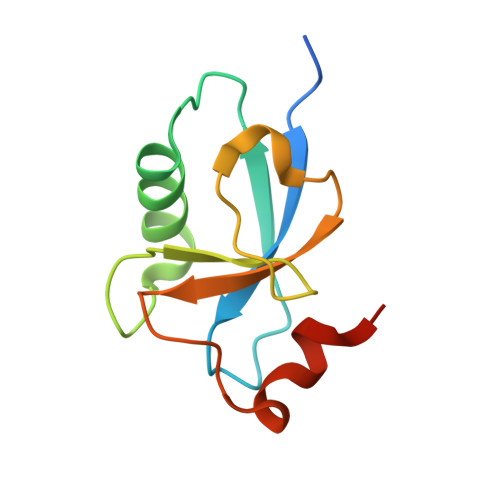A doublecortin-domain protein of Toxoplasma and its orthologues bind to and modify the structure and organization of tubulin polymers.
Leung, J.M., Nagayasu, E., Hwang, Y.C., Liu, J., Pierce, P.G., Phan, I.Q., Prentice, R.A., Murray, J.M., Hu, K.(2020) BMC Mol Cell Biol 21: 8-8
- PubMed: 32111164
- DOI: https://doi.org/10.1186/s12860-020-0249-5
- Primary Citation of Related Structures:
6B4A - PubMed Abstract:
TgDCX is a doublecortin-domain protein associated with the conoid fibers, a set of strongly curved non-tubular tubulin-polymers in Toxoplasma. TgDCX deletion impairs conoid structure and parasite invasion. TgDCX contains two tubulin-binding domains: a partial P25α and the DCX/doublecortin domain. Orthologues are found in apicomplexans and their free-living relatives Chromera and Vitrella. We report that isolated TgDCX-containing conoid fibers retain their pronounced curvature, but loss of TgDCX destabilizes the fibers. We crystallized and determined the 3D-structure of the DCX-domain, which is similar to those of human doublecortin and well-conserved among TgDCX orthologues. However, the orthologues vary widely in targeting to the conoid in Toxoplasma and in modulating microtubule organization in Xenopus cells. Several orthologues bind to microtubules in Xenopus cells, but only TgDCX generates short, strongly curved microtubule arcs. EM analysis shows microtubules decorated with TgDCX bundled into rafts, often bordered on one edge by a "C"-shaped incomplete tube. A Chromera orthologue closely mimics TgDCX targeting in Toxoplasma and binds to microtubules in Xenopus cells, but does not generate arcs or "C"-shaped tubes, and fails to rescue the defects of the TgDCX-knockout parasite. These observations suggest that species-specific features of TgDCX enable it to generate strongly curved tubulin-polymers to support efficient host-cell invasion.
Organizational Affiliation:
Department of Biology, Indiana University, Bloomington, IN, 47405, USA.















